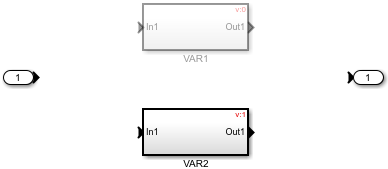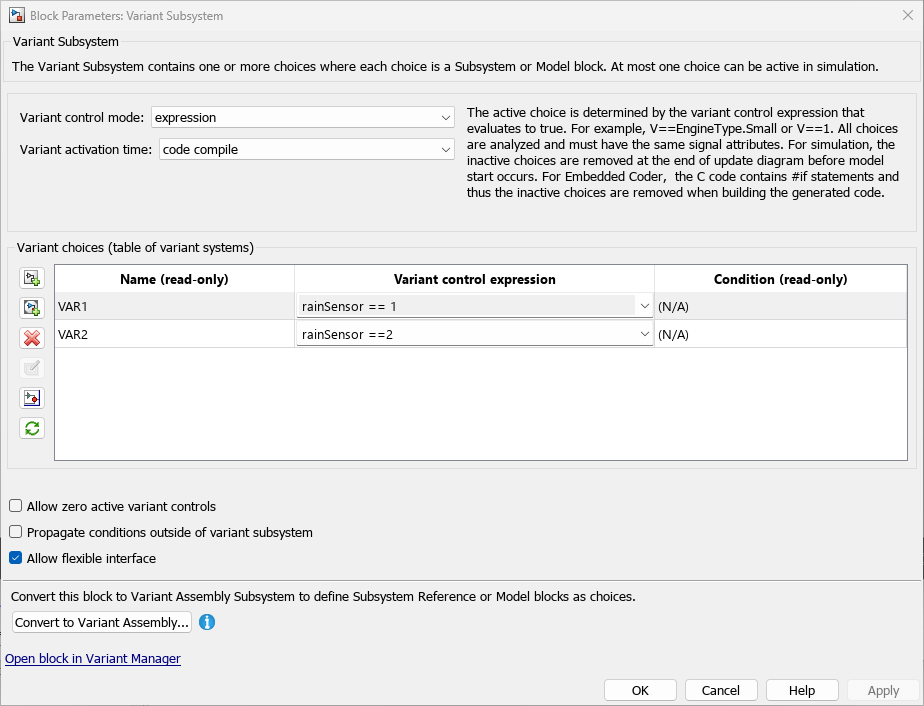Configure Variants for AUTOSAR Runnable Implementations
To vary the implementation of an AUTOSAR runnable, AUTOSAR software components can specify variant condition logic inside a runnable. In Simulink®, to model variant condition logic inside a runnable:
To represent variant implementations of a subsystem or model and define variant condition logic, use a Variant Subsystem block.
To model AUTOSAR system constants, use
AUTOSAR.Parameterdata objects with storage classSystemConstant. The system constants represent the condition values that determine the active subsystem or model implementation.
For example, here is an AUTOSAR component model that contains a Variant Subsystem block, which models two variant implementations of a subsystem. You can open the model by running the following code at the MATLAB® command line.
open_system("mAutosarVariantSubsystem")The variant choices are subsystems VAR1 and VAR2. The blocks are not connected because connectivity is determined during simulation, based on the active variant.

To model an AUTOSAR system constant, the model defines AUTOSAR.Parameter data object rainSensor:
rainSensor = AUTOSAR.Parameter; rainSensor.CoderInfo.StorageClass = 'Custom'; rainSensor.CoderInfo.CustomStorageClass = 'SystemConstant'; rainSensor.DataType = 'uint8'; rainSensor.Value = 2;
The Variant Subsystem block dialog box defines the variant condition logic, which is based on the system constant value. You can specify an expression or a Simulink.VariantExpression object containing an expression.

When you generate code for the model:
In the ARXML code, the variant choices appear as VARIATION-POINT-PROXY entries with short-names c0 and c1.
rainSensorappears as a system constant representing the associated condition value. For example:
<VARIATION-POINT-PROXYS>
<VARIATION-POINT-PROXY UUID="...">
<SHORT-NAME>c0</SHORT-NAME>
<CATEGORY>CONDITION</CATEGORY>
<CONDITION-ACCESS BINDING-TIME="PRE-COMPILE-TIME">
<SYSC-REF DEST="SW-SYSTEMCONST">/vss_pkg/vss_dt/SystemConstants/rainSensor</SYSC-REF>
== 1</CONDITION-ACCESS>
</VARIATION-POINT-PROXY>
<VARIATION-POINT-PROXY UUID="...">
<SHORT-NAME>c1</SHORT-NAME>
<CATEGORY>CONDITION</CATEGORY>
<CONDITION-ACCESS BINDING-TIME="PRE-COMPILE-TIME">
<SYSC-REF DEST="SW-SYSTEMCONST">/vss_pkg/vss_dt/SystemConstants/rainSensor</SYSC-REF>
== 2</CONDITION-ACCESS>
</VARIATION-POINT-PROXY>
</VARIATION-POINT-PROXYS>
In the RTE compatible C code, short-names
c0andc1are encoded in the names of preprocessor symbols used in the variant condition logic. For example:
#if Rte_SysCon_c0 ... #elif Rte_SysCon_c1 ... #endif
See Also
Variant Subsystem | AUTOSAR.Parameter